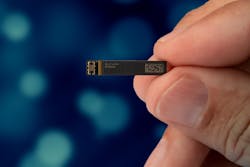GlobalFoundries Partners with Qualcomm to Deliver 5G RF Front Ends
GlobalFoundries is expanding its partnership with Qualcomm to build radio-frequency (RF) front-end solutions for 5G phones and other devices.
Together, the companies will co-develop advanced 5G RF front-end (RFFE) technologies that can run at more than 1 Gb/s and fit inside the slim form factors that consumers have come to expect of 4G LTE smartphones.
Qualcomm, the world's largest smartphone chip vendor, is wrestling to win more market share in RF chips surrounding the cellular modem, RF transceivers, and antennas to perform jobs such as amplifying and filtering radio signals. The chips are invaluable to getting the best possible performance out of 5G phones. Qualcomm, up against Qorvo, Skyworks, and Broadcom, is trying to suction up more of the bill of materials (BOM) in 5G gadgets.
In July, CEO Cristiano Amon said Qualcomm was on track to become the world’s largest smartphone RF front-end supplier by revenue, though he did not give a timeline for when that would happen.
The San Diego, Calif.-based company said its RF front-end business more than doubled year-over-year to close to $960 million in the third quarter, buoyed by strong demand for power amplifiers, antenna tuners, envelope trackers, filters, diversity modules, and other 5G phone parts. That has forced it to secure more capacity at its foundry partners. Qualcomm is one of the world’s largest fabless semiconductor vendors. So it depends on contractors such as GlobalFoundries, TSMC, and Samsung to build chips based on its blueprints.
"With accelerating demand for RF front-end products in a 5G world, robust low-power semiconductor solutions are critical," Christian Block, Qualcomm senior vice president and general manager of RFFE, said in a statement.
Under CEO Tom Caulfield, GlobalFoundries has pivoted from playing in the most advanced nodes to focusing on special-purpose chips used in areas such as power management, image sensors, radio-frequency, displays, and many others. GlobalFoundries, the world’s No. 3 chip foundry behind TSMC and UMC, is trying to differentiate itself in non-single-digit and other specialty nodes, which now account for 75% of the foundry sector's revenue.
At its annual technology conference, GlobalFoundries said it upgraded its FDX-RF node—its RF-focused fully-depleted silicon-on-insulator (FD-SOI) technology—so that customers can roll out millimeter-wave chips that shoot out stronger, clearer signals over 5G networks while consuming less power. In addition, new features in its RF-SOI promises to wring more performance out of power amplifiers and other chips that support sub-6 bands.
GlobalFoundries is also a major supplier to Qualcomm’s rivals in the radio-frequency arena, most notably Qorvo and Skyworks.
"GlobalFoundries continues to lead in RF with feature-rich technology solutions for 5G," said Bami Bastani, senior vice president and general manager of GF’s mobile and wireless infrastructure business, in a statement.
About the Author
James Morra
Senior Editor
James Morra is the senior editor for Electronic Design, covering the semiconductor industry and new technology trends, with a focus on power electronics and power management. He also reports on the business behind electrical engineering, including the electronics supply chain. He joined Electronic Design in 2015 and is based in Chicago, Illinois.

